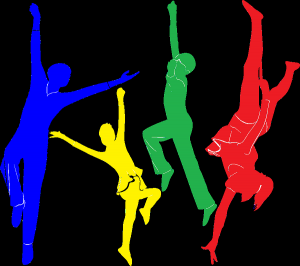Hyperkinesis: an Under-Utilized Interview Tool

Hyperactivity—or more precisely in this context, “hyperkinesis “, which, although generally nuanced as pejoratively as “hyperactivity”, is a term I want to use stripped of such negative connotations. (If you insist that “hyperkinesis” is a negative concept, how about “superkinesis” instead?)
That is to say, vigorous motion and lots of it—”hyperkinesis”, as I am using the term—attracts attention, and the more complex, engaging or disciplined the motion, the more positive the attention. Expressed differently, the squeaky wheel may get the grease, but the spinning one wins the race.
For example, if you want to get the attention of consumers, just throw up an ad with somebody prancing, jumping, leaping, dancing, juggling or simply making goofy, clownish movements (and shouting—which enhances the impact).
It works with infants, toddlers and consumers equally well as an attention-grabbing, impressive and ingratiating tactic.
Hyperkinesis is also at the heart of sports, beauty contest talent competitions, ballet and attention-getting beach volley ball and dance club displays of figure and fitness—just as it is a programming essential of preschool daycare.
So, why not incorporate it into interviews and shake things up with the equivalent of a shaken baby rattle? Given its incredible sales and other attention-getting power, why not make hyperkinesis a prominent part of the interview process?
Learning Hyperkinesis from Hyperkinetic Professors
Before you scoff at the idea of using hyperactivity as a professional presentation pitch tool, consider the fast-moving, endlessly gesticulating and pacing college lecturer who mesmerizes his students in a way that a static, lectern-clutching prof simply cannot (even though the latter will induce a hypnotic state of his own, namely, a coma).
Sure content counts; but content on the move counts more, just as moving trains impress passengers more than parked ones.
Incorporating hyperkinesis in interviews is neither as farfetched nor as difficult as it may initially seem to be as an interview tactic.
Obviously, a candidate who walks in juggling knives and torches is not going to improve his chances of being hired—unless it’s a juggler’s job.
But, what about as a minimum, utilizing dynamic gestures—the way virtually every presidential candidate who has thumbs has, at least since and including JFK (who elevated the thumb air-jab into a performing art form).
Interview Applications of Hyperkinesis
Putting hyperkinesis into practice can be very straightforward, even though it currently seems to be under-utilized in business, apart from advertising.
In particular, applying it in interviews doesn’t require much of a stretch, unless literally stretching, e.g., yoga-style, is part of the performance.
—On the interviewer side, incorporating hyperkinesis can carry a bonus: the opportunity to establish interview physical dominance, in virtue of standing and moving, in contrast to the seated and motionless candidate, whose body will, of necessity, be lower.
As a minimum, whiteboard presentations in the context of a group interview provide the perfect opportunity to capitalize on hyperkinesis, in much the same way as a savvy showman classroom prof does with all that pacing and gesticulating.
—Even if the hyperkinesis is not continuous or otherwise sustained, it can be used to behaviorally punctuate an interview, jolt the candidate into a state of full attention, e.g., by slapping one’s own thigh after saying or hearing something presumably hilarious.
—For Millennials who seem to be unable to string a sentence together without at least one “I’m like”, an interviewer who wants to win such a candidate over, or at least be perceived as cool and comfortable, could inject one uttered “I’m like” with the body language that illustrates what he was visually like at the moment that is being recalled as relived.
For example, he could use a quick head swivel and eye roll to visually and hyperkinetically express a double-take on whatever surprised him in the story being told.
—When anything but decorous rigidity is out of the question, it may be possible to insinuate pseudo-hyperkinesis into the interview, in the form of a narrative about one’s own hyperkinetic behavior.
For example, a candidate shows up breathless for an interview and relates how he sprinted 10 blocks when his taxi got blocked by a traffic-stopping rear-ender.
I imagine that whatever surrogate hyperkinetic impact this may have is theoretically supported by various psychotherapies, e.g., “guided visual therapy “, and life coaching techniques, e.g., neuro-linguistic programming, that emphasize visualization as cathartic, lifestyle enhancing, etc., and having the power to trigger other strong visceral, as well as cognitive responses.
More familiar analogues of this include campfire scary stories that create goose bumps and gasps—at least among very young listeners.
The Baby-Bottom Line
The bottom line in the application of hyperkinesis is simple to grasp: If you want to rattle somebody’s cage, in the sense of really getting their attention (ideally, in a positive way), just wave and shake (like) the equivalent of a rattle.
It works with babies and TV-addicted couch potatoes; it can work in an interview—and is, like a rattle, something that even a baby can, indeed, easily grasp.

